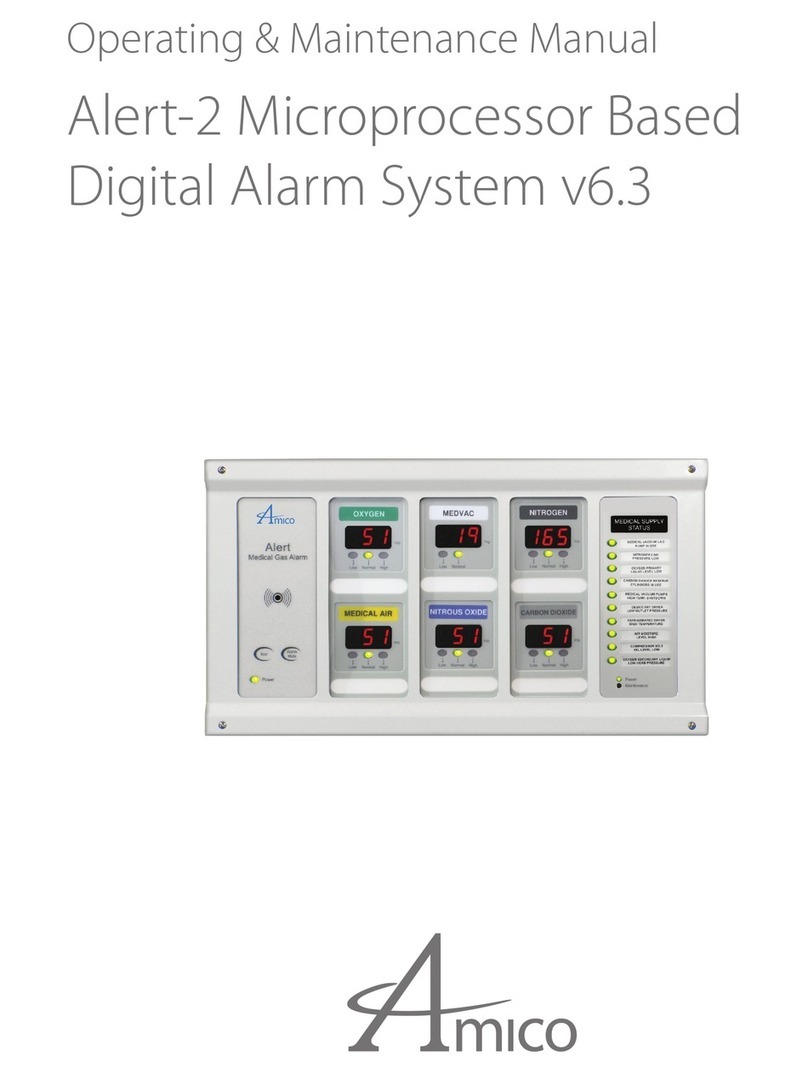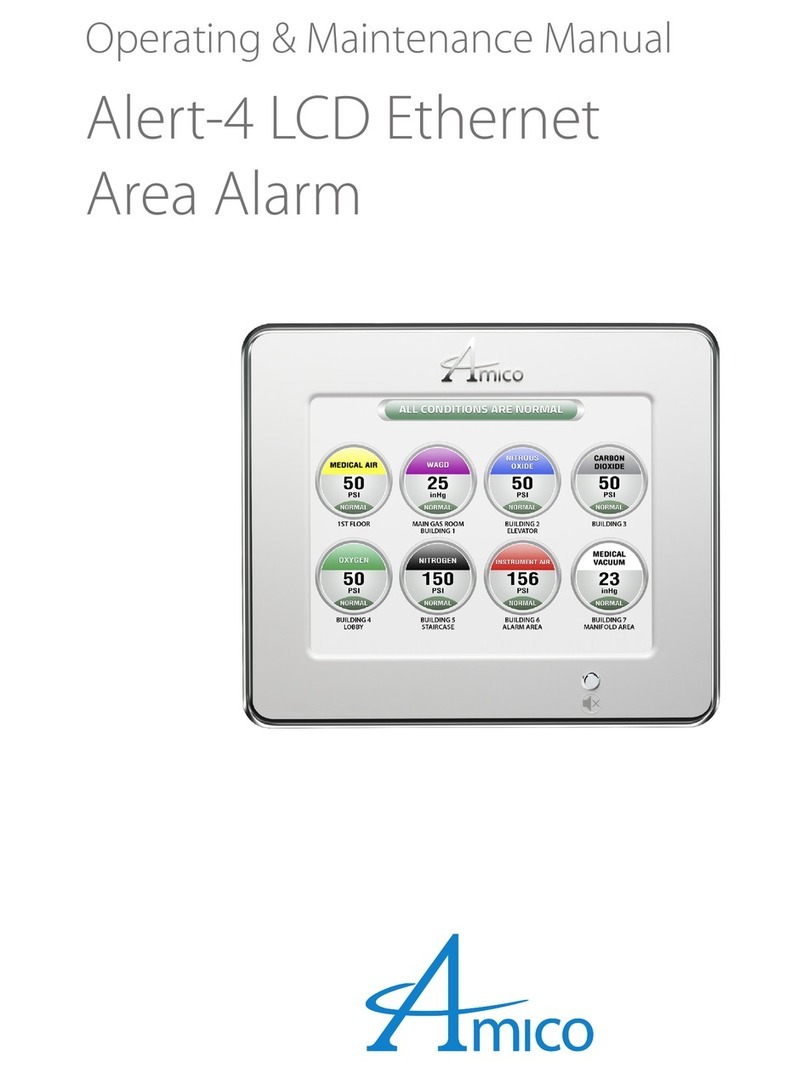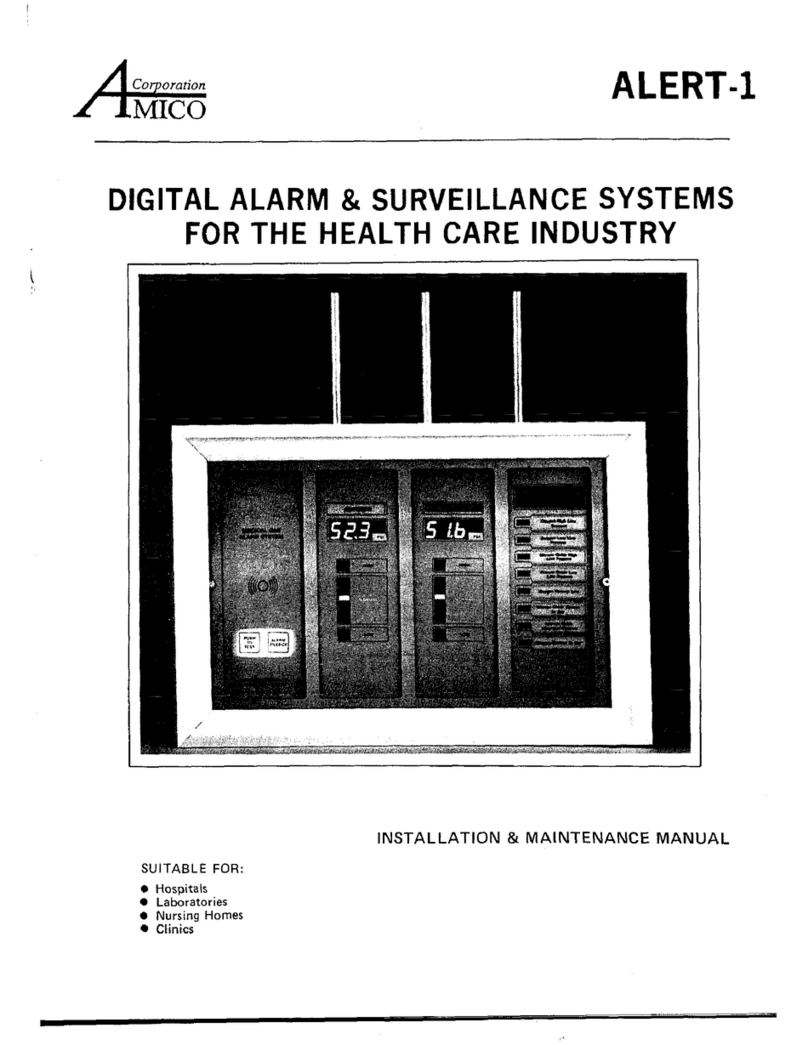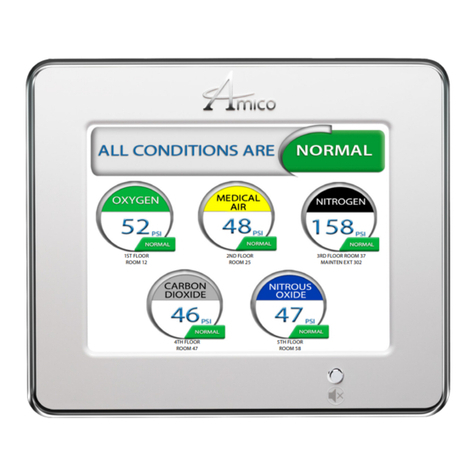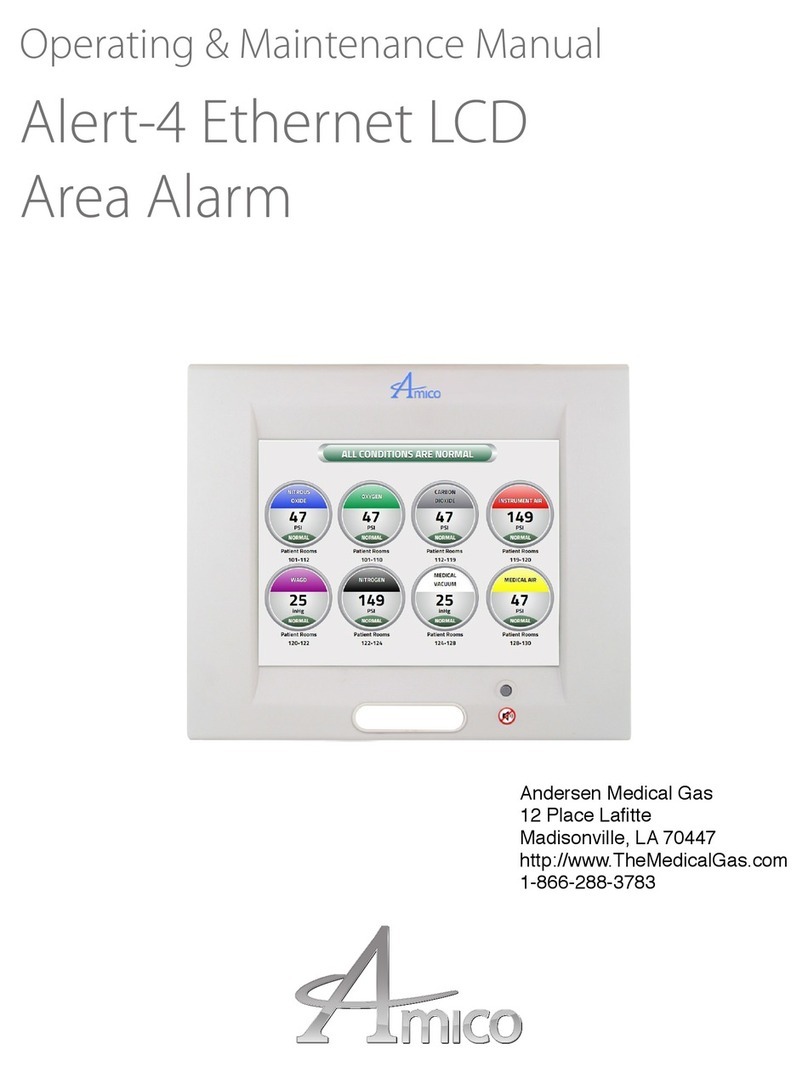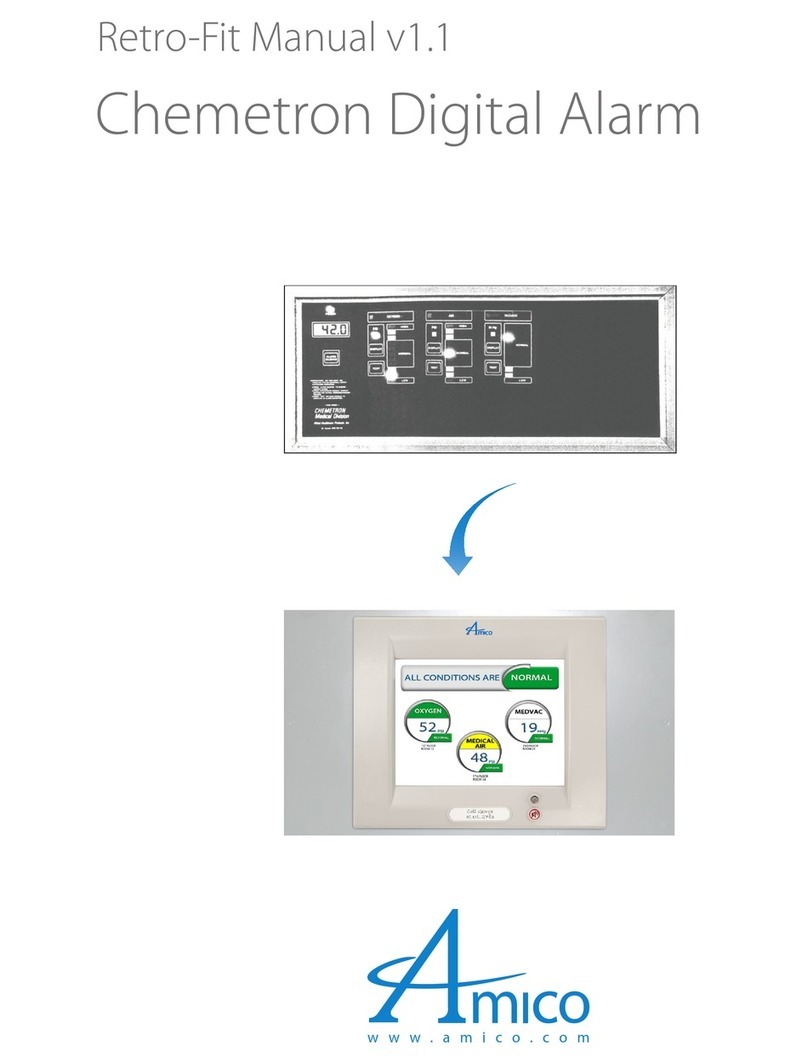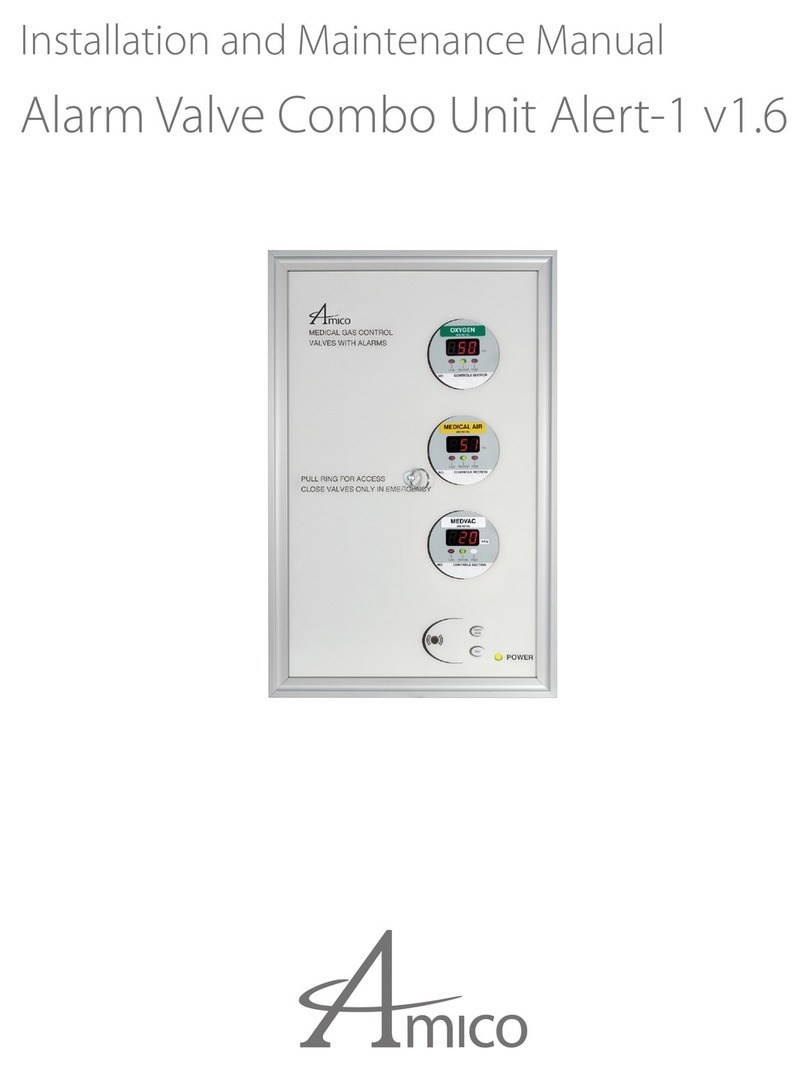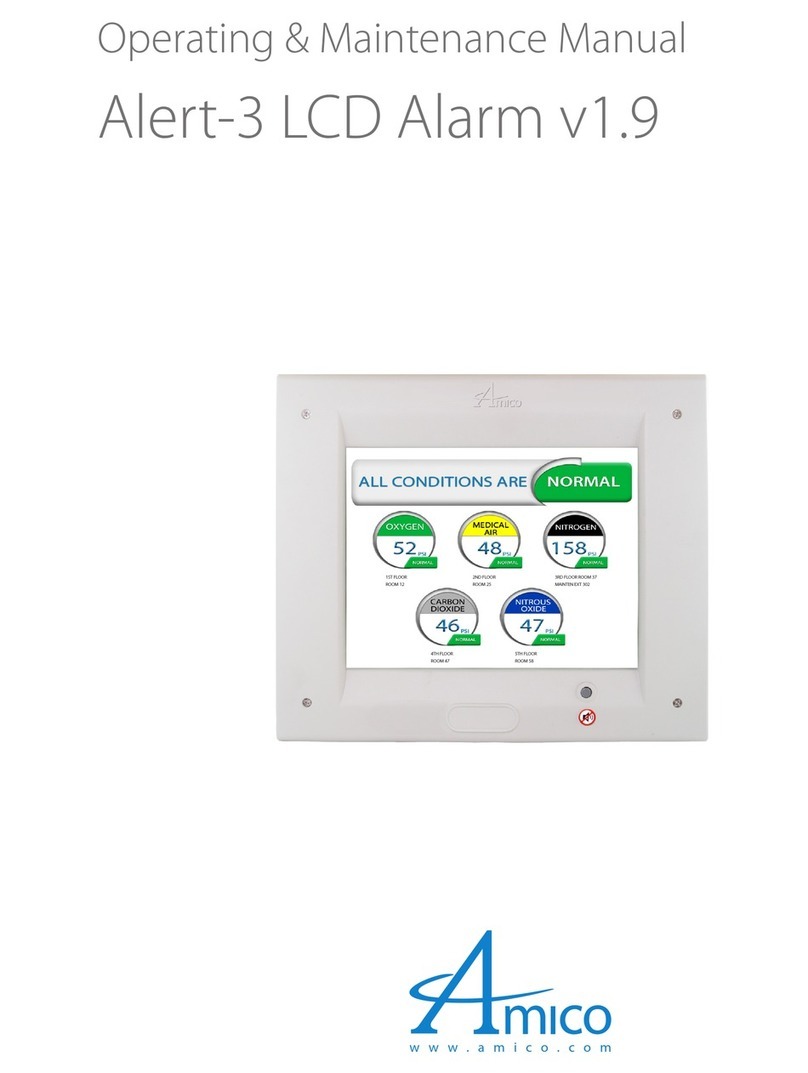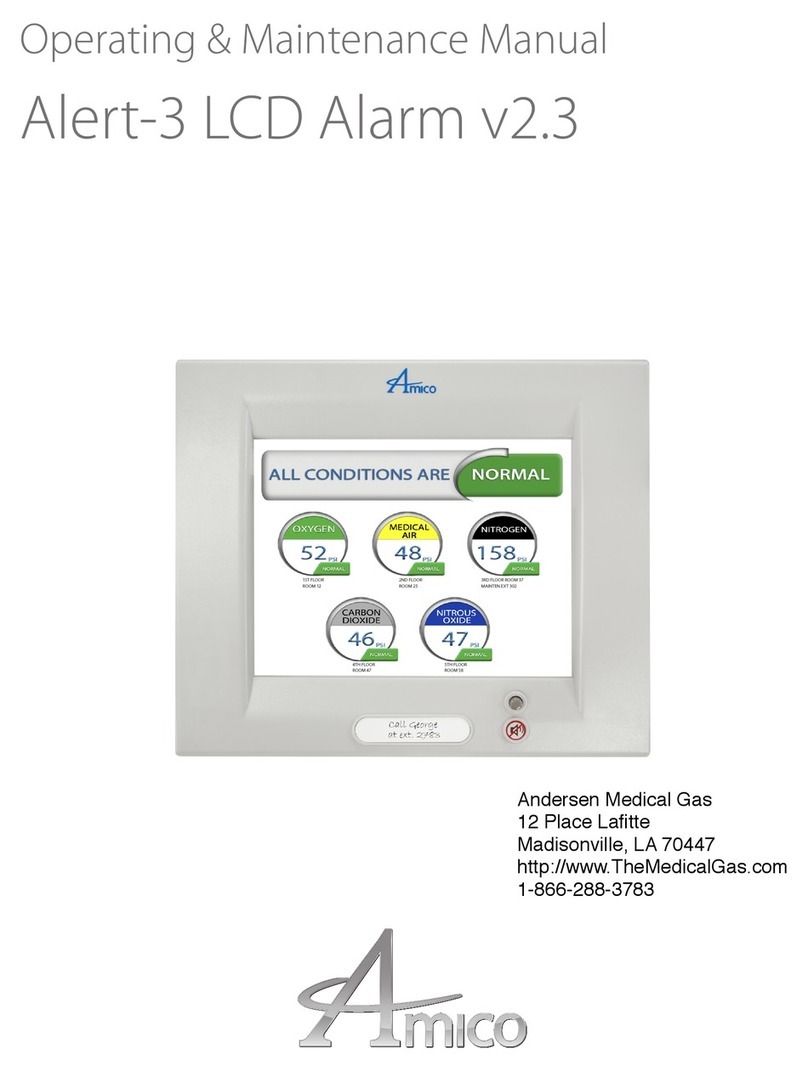
8Amico Pipeline
2. ANNUNCIATOR MODULE
The Annunciator Module contains the buzzer, a “Power On” LED, the “TEST” and the
“ALARM MUTE”buttons. The function of the“TEST”button is to verify that the buzzer and all
the LED’s are in working condition. An alarm will be heard when this button is pushed and
all the LED’s will light up. When the button is released, the alarm will silence. The “ALARM MUTE”
button is used to silence an alarm that has occurred. This module also contains a fail-safe relay
that de-energizes when the buzzer is activated. This relay can be used with the “Amico remote
buzzer”, for applications requiring a remote audible alarm (see Appendix B), for connection to
another Amico Alarm or a Building Management System.
3. BLANK MODULE
The Blank Module is used as a ller board for future provisions of the alarm.
Amico Microprocessor Based Alarm
Page: 8
DESCRIPTION OF MODULES
The ALERT-2 alarm is divided into (4) or (7) main modules:
COMMON TO ALL ALARMS
1. SYSTEM POWER SUPPLY
The System Power Supply has been pre-installed into the back box
assembly. The System Power Supply converts the AC voltage supply to
the alarm into two voltages: 5 VDC (regulated) required by the
microprocessor hardware and 15 VDC (unregulated) required by the
buzzer and the LED’s. This unit also contains the main ON/OFF power
switch, the transformer, the heat sink, the main fuse and fuse cover, the
rectifying circuitry, the terminal blocks and the low voltage DC power
cable for connecting this unit to the annunciator module. The System
Power Supply can be easily removed and reinstalled by unscrewing it
from the back box.
2. ANNUNCIATOR MODULE
The Annunciator Module contains the buzzer, a “Power On” LED, the
“TEST” and the “ALARM MUTE” buttons. The function of the “TEST”
button is to verify that the buzzer and all the LED’s are in working condi-
tion. An alarm will be heard when this button is pushed and all the LED’s
will light up. When the button is released, the alarm will silence. The
“ALARM MUTE” button is used to silence an alarm that has occurred. This
module also contains a fail-safe relay that de-energizes when the buzzer
is activated. This relay can be used with the “Amico remote buzzer”, for
applications requiring a remote audible alarm (see Appendix B), for
connection to an other Amico Alarm or a Building Management System.
3. BLANK MODULE
The Blank Module is used as a filler board for future provisions of the
alarm.
AREA ALARM
4. AREA DISPLAY MODULE
The Area Display Module provides a digital display of the actual pressure/vacuum of a
gas being monitored. In addition a gas trend indicator bar with HIGH and LOW alarms
are displayed. The trend bar has three coloured LED’s: Green for Normal condition, YELLOW
for Caution condition, and RED for high and low Alarm conditions.
Each display module contains a gas specic colour coded label (USA or ISO colours are
available). A space is also provided, at the base of the module, to identify the location that
the display module monitors. The display module is eld adjustable for pressure/vacuum
settings, repeat alarm, and units of measure. Whenever the module is in calibration mode,
the bargraph is ashing, indicating the calibration mode. Dry contacts for high and low
alarms are available for remote monitoring of each module.
5. 2 IN 1 DISPLAY MODULE
The 2 in 1 Display Module provides a digital display of the actual pressure/vacuum of the
gas being monitored. In addition, a gas trend indicator bar with High and Low alarms are
displayed. This module has two coloured LEDs - Green for Normal conditions and Red for
High and Low alarm conditions. It is eld adjustable for pressure/vacuum settings, repeat
alarms, and units of measure. Dry contacts for high and low alarms are available for remote
monitoring of each module.
Each module will continuously monitor up to 5 signals from source equipment or pressure
switches. If any of the signals being monitored go into an alarm condition, a Red LED will
illuminate and the audible alarm will sound.
PLEASE NOTE: Contacts located on back of module are Dry Contacts only.
DO NOT apply any voltage.
Alert - 2 Series
Page: 9
AREA ALARM
4. AREA DISPLAY MODULE
The Area Display Module provides a digital display of the actual
pressure/vacuum of a gas being monitored. In addition a gas trend
indicator bar with HIGH and LOW alarms are displayed. The trend
bar has three coloured LED’s: GREEN for Normal condition, YEL-
LOW for Caution condition, and RED for high and low Alarm
conditions.
Each display module contains a gas specific colour coded label
(USA or ISO colours are available). A space is also provided, at the
base of the module, to identify the location that the display module
monitors. The display module is field adjustable for pressure/vacuum
settings, repeat alarm, and units of measure. Whenever the module
is in calibration mode, the bargraph is flashing, indicating the calibra-
tion mode. Dry contacts for high and low alarms are available for
remote monitoring of each module.
5. 2 IN 1 DISPLAY MODULE
The 2 in 1 Display Module provides a digital display of the actual
pressure/vacuum of the gas being monitored. In addition, a gas
trend indicator bar with High and Low alarms are displayed. This
module has two coloured LEDs - green for Normal conditions and
red for High and Low alarm conditions. It is field adjustable for
pressure/vacuum settings, repeat alarms, and units of measure.
Dry contacts for high and low alarms are available for remote
monitoring of each module.
Each module will continuously monitor up to 5 signals from source
equipment or pressure switches. If any of the signals being
monitored go into an alarm condition, a red LED will illuminate and
the audible alarm will sound.
Please Note: Contacts located on back of module are Dry Contacts
only. DO NOT apply any voltage.
6. SENSOR MODULE
The Sensor Module contains the transducer which converts the
pressure/vacuum pressure source into a digital signal that is dis-
played on the display module. The sensor module is housed in a
black ABS plastic fire rated enclosure to reduce the risk of tamper-
ing. Each sensor is clearly labelled and colour coded for the gas or
vacuum being monitored. The sensor module contains a gas spe-
cific DISS fitting to ensure correct connection of the proper sensor to
the respective gas. Each sensor has been factory calibrated for the
specific gas shown on the sensor housing. If it is not connected to
the appropriate gas display module, an error message (E02) will be
displayed.
Alert - 2 Series
Page: 9
AREA ALARM
4. AREA DISPLAY MODULE
The Area Display Module provides a digital display of the actual
pressure/vacuum of a gas being monitored. In addition a gas trend
indicator bar with HIGH and LOW alarms are displayed. The trend
bar has three coloured LED’s: GREEN for Normal condition, YEL-
LOW for Caution condition, and RED for high and low Alarm
conditions.
Each display module contains a gas specific colour coded label
(USA or ISO colours are available). A space is also provided, at the
base of the module, to identify the location that the display module
monitors. The display module is field adjustable for pressure/vacuum
settings, repeat alarm, and units of measure. Whenever the module
is in calibration mode, the bargraph is flashing, indicating the calibra-
tion mode. Dry contacts for high and low alarms are available for
remote monitoring of each module.
5. 2 IN 1 DISPLAY MODULE
The 2 in 1 Display Module provides a digital display of the actual
pressure/vacuum of the gas being monitored. In addition, a gas
trend indicator bar with High and Low alarms are displayed. This
module has two coloured LEDs - green for Normal conditions and
red for High and Low alarm conditions. It is field adjustable for
pressure/vacuum settings, repeat alarms, and units of measure.
Dry contacts for high and low alarms are available for remote
monitoring of each module.
Each module will continuously monitor up to 5 signals from source
equipment or pressure switches. If any of the signals being
monitored go into an alarm condition, a red LED will illuminate and
the audible alarm will sound.
Please Note: Contacts located on back of module are Dry Contacts
only. DO NOT apply any voltage.
6. SENSOR MODULE
The Sensor Module contains the transducer which converts the
pressure/vacuum pressure source into a digital signal that is dis-
played on the display module. The sensor module is housed in a
black ABS plastic fire rated enclosure to reduce the risk of tamper-
ing. Each sensor is clearly labelled and colour coded for the gas or
vacuum being monitored. The sensor module contains a gas spe-
cific DISS fitting to ensure correct connection of the proper sensor to
the respective gas. Each sensor has been factory calibrated for the
specific gas shown on the sensor housing. If it is not connected to
the appropriate gas display module, an error message (E02) will be
displayed.
